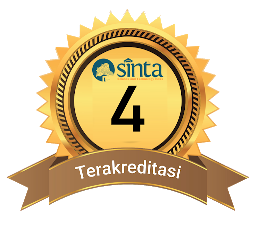Gender Based Analysis of PjBL STEM Capability in Learning Environmental Pollution
Published:
2024-05-31Issue:
Vol. 7 No. 1 (2024): Edisi Mei 2024Keywords:
PjBL STEM, Gender, environmental pollutionArticles
Downloads
How to Cite
Abstract
This research aims to determine the comparison of the implementation of PjBL with the STEM model based on gender. The type of research used is a One-Shot Case Study, namely an experiment carried out without a comparison group. All groups were given learning using PjBL STEM. The STEM aspects observed in this research are aspects of science (S), science–technology (S–T), science–engineering (S–E), and science–mathematics (S–M). The data collection method uses a series of questionnaires and tests. Data analysis uses N-gain to see an increase in learning outcomes regarding environmental pollution material. The research results show that STEM applications are not influenced by gender. It can be seen that student learning outcomes have increased with average N_gain of 0.92 and 0.83 respectively (high category).
References
Afriana, Permanasari, & Fitriani. Project Based Learning Integrated To Stem To Enhance Elementary School’s Students Scientific Literacy. Jurnal Pendidikan IPA Indonesia. Vol 5(2).
Arends, R. 2012. Learning to teach (9th Editio). New York: The McGraw-Hill Companies, Inc.
Baran, M. & Maskan, A. (2010). The Effect of project-based learning on pre-service
physics teachers’ electrostatic achievements. Cypriot Journal of Educational Sciences, 5,
Bybee, R. W. 2010. Advancing STEM Education: A 2020 Vision. Technology and Engineering Teacher, 70
Cooper & Heaverlo, 2013. Problem Solving And Creativity And Design: What Influence Do They Have On Girls’ Interest In STEM Subject Areas?. American Journal of Engineering Education – Spring. Special Edition Vol 4(1)
Gocen, A., & Sen, S. 2021. A Validation of Servant Leadership Scale on Multinational Sample.Psychological Reports,124(2)
Gunawan & liliasari. 2012. Model Virtual Laboratory Fisika Modern untuk Meningkatkan Disposisi Berpikir Kritis Calon Guru. Cakrawala Pendidikan. vol 2(1)
Hango, D. 2013. Gender differences in science, technology, engineering, mathematics and computer science (STEM) programs at university Insights on Canadian Society. In Insights on Canadian Society (pp. 1–11).
Jannah, F., Fadly, W., & Aristiawan, A. (2021). Analisis karakter rasa ingin tahu siswa pada tema struktur dan fungsi tumbuhan. Jurnal Tadris IPA Indonesia, 1(1), 1–16
Kapila, V. & Iskander, M., 2014. Lessons Learned from Conducting a K-12 Project to Revitalize Achievement by using Instrumentation in Science Education. Journal of STEM Education Vol 15 (1)
Kemdikbud. (2014). Materi pelatihan guru implementasi kurikulum 2013 tahun ajaran 2014/2015: Mata pelajaran IPA SMP/MTs. Jakarta: Kementerian Pendidikan dan Kebudayaan
Kulturel-Konak, S., D’Allegro, M. Lou, & Dickinson, S. (2011). Review of gender differences in learning styles: Suggestions for STEM education. Contemporary Issues in Education Research, CIER. Vol 4(3)
OECD. (2014). PISA 2012 results in focus: What 15-year-olds know and what they can do with what they know. OECD Publishing
Ormancı, Ü. (2020). Thematic content analysis of doctoral theses in STEM education: Turkey context. Journal of Turkish Science Education,17(1),
Rouquette A, Hardouin J-B, Vanhaesebrouck A, Sébille V, Coste J (2019) Differential Item Functioning (DIF) in composite health measurement scale: Recommendations for characterizing DIF with meaningful consequences within the Rasch model framework. PLoS ONE 14(4)
Sumartati, L. (2020). Pendekatan Science, Technology, Engineering And Mathematics Dalam Pembelajaran Kimia 4.0. JENTRE, 1(1), 1-8.
Vennix, J., den Brok, P., & Taconis, R. (2018). Do outreach activities in secondary STEM education motivate students and improve their attitudes towards STEM?. International Journal of Science Education, 40(11).
Yalçin, S. A., Turgut, Ü., & Büyükkasap, E. (2009). The effect of project based learning on science undergraduates’ learning of electricity, attitude towards physics and scientific process skills.International Online Journal of Educational Sciences, 1(1),
Ying-Tien Wu, Y & Anderson, O. R. 2015. Technology-enhanced stem (science, technology, engineering, and mathematics) education. J. Comput. Educ. 2(3):245–249 DOI 10.1007/s40692-015-0041-2
Zulfa, A. R., & Rosyidah, Z. (2020). Analysis Of Communication Skills Of Junior High School Students On Classification Of Living Things Topic. Integrative Science Education and Teaching Activity Journal, 1(1)
Author Biographies
Syarifa Wahidah Al-Idrus, Pendidikan Kimia, FKIP, Universitas Mataram
Rahmawati Rahmawati, Pendidikan Kimia, FKIP, Universitas Mataram
License
Copyright (c) 2024 Dewandi Saputra

This work is licensed under a Creative Commons Attribution-ShareAlike 4.0 International License.
Authors who publish with Chemistry Education Practice agree to the following terms:
- Authors retain copyright and grant the journal right of first publication with the work simultaneously licensed under a Creative Commons Attribution License 4.0 International License (CC-BY-SA License). This license allows authors to use all articles, data sets, graphics, and appendices in data mining applications, search engines, web sites, blogs, and other platforms by providing an appropriate reference. The journal allows the author(s) to hold the copyright without restrictions and will retain publishing rights without restrictions.
- Authors are able to enter into separate, additional contractual arrangements for the non-exclusive distribution of the journal's published version of the work (e.g., post it to an institutional repository or publish it in a book), with an acknowledgement of its initial publication in Chemistry Education Practice.
- Authors are permitted and encouraged to post their work online (e.g., in institutional repositories or on their website) prior to and during the submission process, as it can lead to productive exchanges, as well as earlier and greater citation of published work (See The Effect of Open Access).






